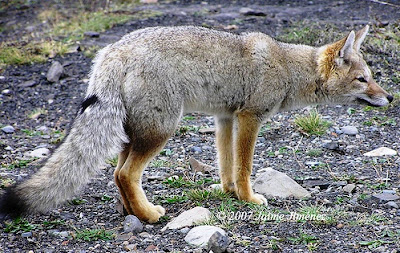Вы не зашли.
Объявление
"Давайте только проявлять больше внимания, терпимости и уважения к чужому мнению — вот и всё." — Gennadius.
— О размещении изображений на форуме, О рекламе на форуме
#1 05 April 2016 16:13:38
- Wolf
- Без пяти минут зоолог

- Зарегистрирован: 13 January 2009
- Сообщений: 2583
Парагвайская лисица (Lycalopex gymnocercus)
Еще 1 представитель рода Lycalopex. По этому виду нашел больше информации, чем по другим двум этого же рода. Прикрепляю постом ниже.
Отредактировано Wolf (05 April 2016 16:19:46)
Per aspera ad astra
Неактивен
#2 05 April 2016 16:18:57
- Wolf
- Без пяти минут зоолог

- Зарегистрирован: 13 January 2009
- Сообщений: 2583
Re: Парагвайская лисица (Lycalopex gymnocercus)
Из Википедии и карниворы:
Длина тела составляет примерно 65 см, высота в холке — примерно 40 см, средний вес — от 4 до 6,5 кг. Окрас шерсти на верху и по бокам головы красноватая, а на спине от красноватого до чёрного цвета. Нижняя часть головы от бледно-серого до белого цвета. Уши треугольные, широкие, относительно крупные, красноватые на внешней поверхности и белые на внутренней. Спина, плечи и боковые стороны тела серые. Черноватая линия проходит по центру спины и хвоста. Хвост относительно длинный (50% от длины головы и тела), пушистый и серый с чёрным кончиком. Брюхо и внутренняя поверхность ног от бледно-серого до беловатого цвета. Задние конечности серые с боков, с характерной чёрным пятном на нижней задней стороне. Боковая поверхность передних конечностей красноватая. Мех лисицы зимой становится толще и длиннее. Передние лапы имеют 5 пальцев, 4 с полными когтями и 1 с рудиментным когтем (этот палец не формирует отпечаток на поверхности); задние лапы имеют 4 пальца. 42 зуба
The pampas foxes mostly live a solitary life, but come together as monogamous pairs in the breeding season to raise their young. They are mainly nocturnal, becoming active at dusk, although it may also be active during the day. They den in any available cavity, including caves, hollow trees, and the burrows of viscachas or armadillos. Even when raising young together, adult foxes generally hunt alone, marking their territory by defecating at specific latrine sites. Although there is considerable variation, the home range of a typical pampas fox has been estimated at around 260 hectares (640 acres).
Pampas foxes are more omnivorous than most other canids, and have a varied and opportunistic diet. Their primary prey consists of birds, rodents, hares, fruit, carrion, and insects, although they will also eat lizards, armadillos, snails and other invertebrates, lambs, and the eggs of ground-nesting birds. Their primary predators are pumas and domestic dogs. If a threatening or larger animal comes near it is known to play dead with its eyes closed and will stay there until the animal leaves.
Pampas foxes breed in the early spring, with the female coming into heat just once each year. After a gestation period of 55 to 60 days, the mother gives birth to a litter of up to eight kits. The young are born between September and December, and are weaned at around two months of age. Females reach sexual maturity in their first year, and animals have lived for up to 14 years in captivity. Pups will hunt with parents when they are 3 months old. The males bring food to their females who stay at the den with kits.




Per aspera ad astra
Неактивен